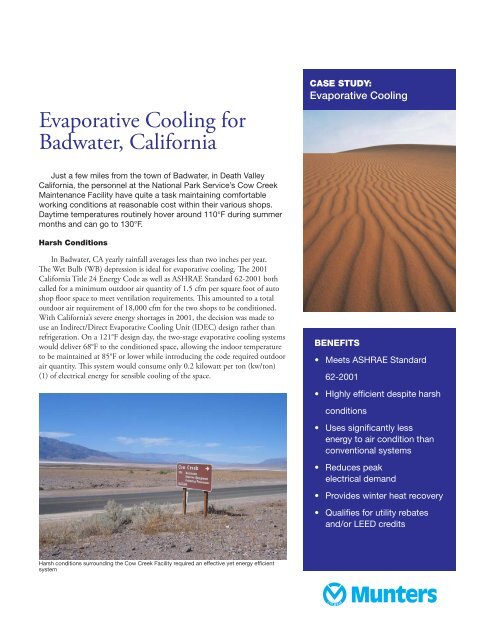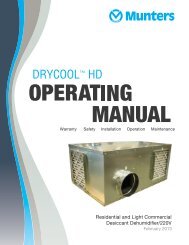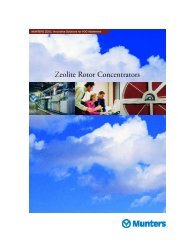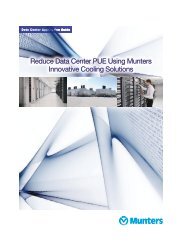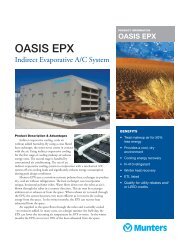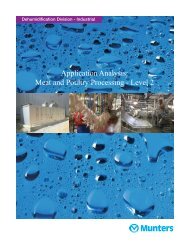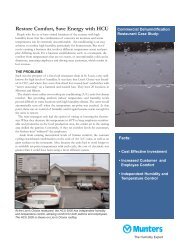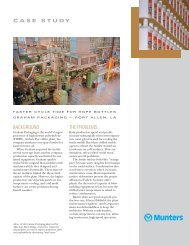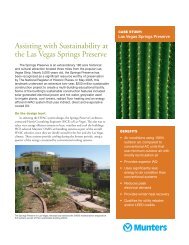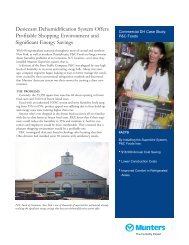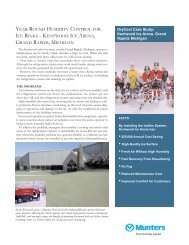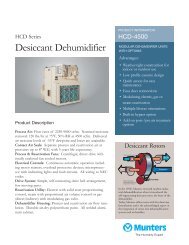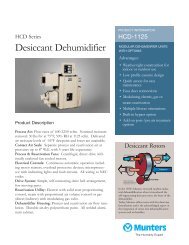Evaporative Cooling for Badwater, California - Munters
Evaporative Cooling for Badwater, California - Munters
Evaporative Cooling for Badwater, California - Munters
Create successful ePaper yourself
Turn your PDF publications into a flip-book with our unique Google optimized e-Paper software.
<strong>Evaporative</strong> <strong>Cooling</strong> <strong>for</strong><br />
<strong>Badwater</strong>, Cali<strong>for</strong>nia<br />
Just a few miles from the town of <strong>Badwater</strong>, in Death Valley<br />
Cali<strong>for</strong>nia, the personnel at the National Park Service’s Cow Creek<br />
Maintenance Facility have quite a task maintaining com<strong>for</strong>table<br />
working conditions at reasonable cost within their various shops.<br />
Daytime temperatures routinely hover around 110°F during summer<br />
months and can go to 130°F.<br />
Harsh Conditions<br />
In <strong>Badwater</strong>, CA yearly rainfall averages less than two inches per year.<br />
The Wet Bulb (WB) depression is ideal <strong>for</strong> evaporative cooling. The 2001<br />
Cali<strong>for</strong>nia Title 24 Energy Code as well as ASHRAE Standard 62-2001 both<br />
called <strong>for</strong> a minimum outdoor air quantity of 1.5 cfm per square foot of auto<br />
shop floor space to meet ventilation requirements. This amounted to a total<br />
outdoor air requirement of 18,000 cfm <strong>for</strong> the two shops to be conditioned.<br />
With Cali<strong>for</strong>nia’s severe energy shortages in 2001, the decision was made to<br />
use an Indirect/Direct <strong>Evaporative</strong> <strong>Cooling</strong> Unit (IDEC) design rather than<br />
refrigeration. On a 121°F design day, the two-stage evaporative cooling systems<br />
would deliver 68°F to the conditioned space, allowing the indoor temperature<br />
to be maintained at 85°F or lower while introducing the code required outdoor<br />
air quantity. This system would consume only 0.2 kilowatt per ton (kw/ton)<br />
(1) of electrical energy <strong>for</strong> sensible cooling of the space.<br />
Harsh conditions surrounding the Cow Creek Facility required an effective yet energy efficient<br />
system<br />
CASE STUDY:<br />
<strong>Evaporative</strong> <strong>Cooling</strong><br />
BENEFITS<br />
• Meets ASHRAE Standard<br />
62-2001<br />
• HIghly efficient despite harsh<br />
conditions<br />
• Uses significantly less<br />
energy to air condition than<br />
conventional systems<br />
• Reduces peak<br />
electrical demand<br />
• Provides winter heat recovery<br />
• Qualifies <strong>for</strong> utility rebates<br />
and/or LEED credits
A New Heat Exchanger<br />
Hard water and high ambient temperatures require a robust airto-air<br />
heat exchanger which will shed minerals plated out during<br />
the Indirect <strong>Evaporative</strong> <strong>Cooling</strong> (IEC) process. With a wet-bulb<br />
depression at design of 44°F (ambient 121°F dry bulb minus<br />
77°F wet bulb), there would be a significant evaporation rate on<br />
the wet side of the heat exchanger surface.<br />
Since heat exchanger effectiveness is a function of surface<br />
area, the heat exchanger must present maximum surface yet<br />
minimize air-side pressure losses. Early designs of IEC modules<br />
used a folded aluminum, cross-flow matrix or round plastic shell<br />
and tube type heat transfer surfaces. The limitations of these<br />
pioneer products were wet-side fouling and short life expectancy.<br />
In addition, the shell and tube design has high static pressure<br />
losses and low efficiency.<br />
Improved Conditions<br />
At Cow Creek, where two of the new IEC modules are<br />
installed, dry side static pressure losses are in the range of 0.6 to<br />
0.7 inch water gauge (in. w.g.) and wet side losses are 0.8 to 0.9<br />
in. w.g. at design cfm flows with an 80% approach of ambient<br />
dry bulb to ambient wet bulb. This approach is often called Wet<br />
Bulb Depression Efficiency (WBDE). Water consumption at<br />
design temperatures, due to evaporation, is estimated to be 608.5<br />
pounds of water per hour (1.22 gpm) per 10,000 cfm of supply<br />
air flow. Since outdoor air is dry cooled from 121°F to 85°F with<br />
the IEC heat exchanger, the cooling effect is equal to 33 tons of<br />
sensible cooling per 10,000 cfm of supply air. The air is induced<br />
vertically up through the inside of the vertical tubes with a<br />
propeller fan while water is sprayed down through the wet side<br />
matrix or the inside of the tubes. A moisture eliminator on top of<br />
the water spray manifold insures no carry-over off the wet side of<br />
the heat exchanger.<br />
A concern of many designers is exposed water in the supply<br />
air stream. In Cali<strong>for</strong>nia, most hospital applications may not use<br />
direct evaporative cooling components due to the exposed water<br />
<strong>Munters</strong> Corporation<br />
Tel: (800) 843-5360<br />
E-mail: dhinfo@munters.com<br />
www.munters.us<br />
CS0019-02 05/09<br />
that could lead to potential growth of allergenic or pathogenic<br />
organisms. The new tube sheet sealing method results in a<br />
tighter seal eliminating cross-contamination. Water leakage<br />
specifications now call <strong>for</strong> less than 0.001 gallon per hour leakage<br />
between supply and wet side air paths <strong>for</strong> a 10,000 cfm unit.<br />
Direct <strong>Evaporative</strong> <strong>Cooling</strong> in the Desert<br />
A 12-inch deep wetted media pad, selected <strong>for</strong> 400 feet/<br />
min. face velocity, provided the final stage of cooling <strong>for</strong> the Cow<br />
Creek project. The static pressure loss <strong>for</strong> the Direct <strong>Evaporative</strong><br />
Cooler (DEC) section is 0.14 in. w.g. and the evaporation rate<br />
is estimated to be 215.6 lb/hr (0.43 gpm) at summer design<br />
conditions. The WBDE of the adiabatic cooler is 90.2 %.<br />
A major contribution of the IEC heat exchanger is its ability<br />
to generate the lower wet bulb condition of 66.7°F which allows<br />
the second stage DEC to deliver 68.4°F to the room. This<br />
then increases the overall system sensible cooling tonnage from<br />
33 tons <strong>for</strong> the IEC alone to a total of 48.2 tons <strong>for</strong> the total<br />
evaporative cooling unit per 10,000 cfm of supply air.<br />
Conclusion<br />
Since 1997 the heat exchangers used in the Cow Creek<br />
Maintenance Facility have functioned as intended in numerous<br />
applications without maintenance or operational issues.<br />
According to Mr. Booth, “the equipment is supplying air that<br />
adequately cools the supplied space.” To the authors’ knowledge<br />
no other IEC cooling heat exchanger has per<strong>for</strong>med in such a<br />
manner.<br />
Two Stage <strong>Evaporative</strong> <strong>Cooling</strong> Delivers 48.2 Tons of Sensible <strong>Cooling</strong> in Death<br />
Valley, Cali<strong>for</strong>nia.<br />
(1) Scofield, C. Mike and Des Champs, Nicholas H., “Indirect <strong>Evaporative</strong> Cooing<br />
Using Plate Type Heat Exchangers”, ASHRAE Transactions, 1984, V.90, PT.1.<br />
(2) Scofield, Mike, “Indirect <strong>Evaporative</strong> <strong>Cooling</strong> Uses Outdoor Air to Reduce<br />
<strong>Cooling</strong> Costs <strong>for</strong> Surgery Suites”, The Air Conditioning, Heating and<br />
Refrigeration News, March 16, 1998.


